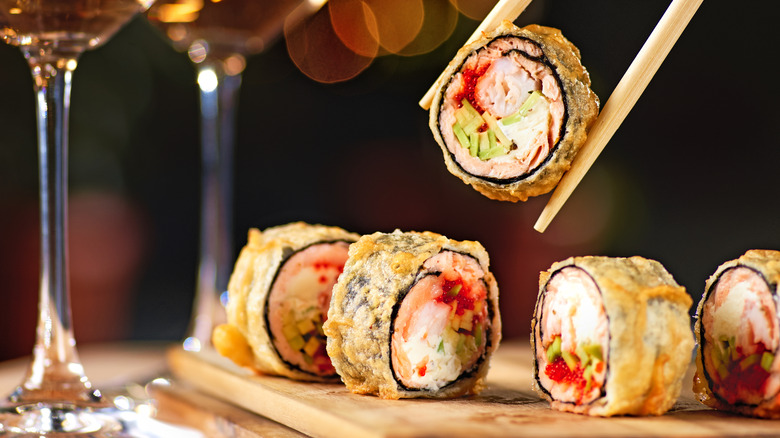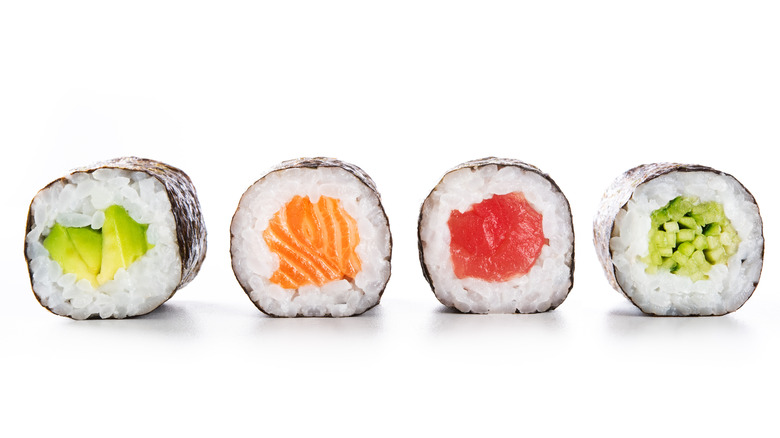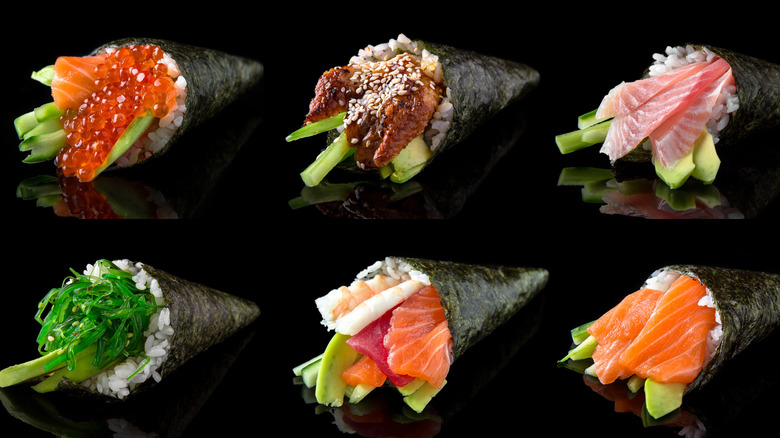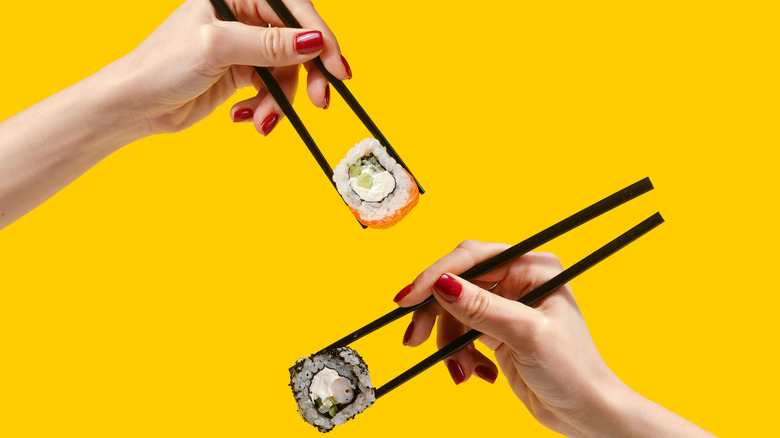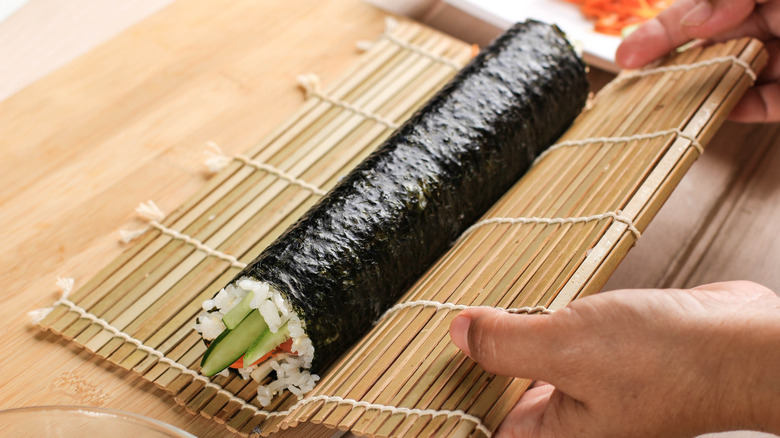Sushi Roll Vs Hand Roll: What's The Difference?
Sushi lovers pride themselves on knowing the difference between the rolls, but for some, sushi is more of a fun treat than a regular visit, and the names of the various types of rolls can be incredibly overwhelming. Maki, Hand Roll, Naruto... the list goes on and on. And even more overwhelming, there are rules that apply to each roll. Two sushi rolls that often get confused with one another are sushi rolls and hand rolls.
While similar in fillings, these two rolls are very different in execution. Sushi rolls, otherwise known as maki rolls, according to Tablespoon, are nori seaweed rolls that include an interior layer of rice along with chosen fillings and cut into 6-8 pieces. Hand rolls on the other hand are known as temaki, and rolled into a cone shape. We break down the keys differences between these two popular sushi orders and help you make an informed decision as to which one you prefer.
What is a sushi roll?
As Mix It Restaurant points out, traditional sushi rolls are almost always maki rolls. airKitchen tells the history of the roll, citing its origins in "the latter half of the 18th century." It started as a combination of sushi rice that had been treated with vinegar being layered onto a nori roll, topped with accouterments like fresh fish and seafood, vegetables, egg, or natto (fermented soybeans), then rolled into a tube shape and cut into 6-8 pieces. Typically, maki rolls are eaten using chopsticks if you can figure out how to use them, but using your hands is ok, too.
Maki sushi comes in three basic sizes, per airKitchen: "hosomaki (small), nakamaki (medium), and futomaki (large)," but also comes in a variety of other forms, including "Tekka Maki" which roughly translates to "iron and fire," named for "the bright red color of the maguro tuna it contains." This is the sushi most people are accustomed to eating.
What is a hand roll?
A hand roll is something altogether different. (As Republic World notes, the hand roll even has its own national holiday founded by the group that owns Sugarfish and other popular fishy joints.) Hand rolls, otherwise known as Temaki, are shaped like cones and remain uncut. They're known as hand rolls because instead of eating with chopsticks, these are eaten with your hands.
These rolls typically include similar ingredients to the hand roll (though in smaller portions to fit the alternate shape): vinegared sushi rice, fish, various vegetables, and a nori wrap. You also make this roll differently, because a hand roll utilizes a rolling mat, while Temaki is hand-rolled.
So really at the end of the day, it all comes down to how hungry you are. If you want some more fillings and pieces, go maki roll, but if you want something fun you can eat with your hands, Temaki it is!
How to eat each roll
Some foods just have a proper way to eat them, and following these unspoken rules will likely make your experience more enjoyable. Sushi is definitely one of those foods. Chefs have been giving tips on how best to eat it for years. Of course, you do you, but if you do want to know how to get the best out of every bite, here are some pointers.
For sushi rolls, Roka Akor suggests you start by adding a bit of soy sauce to the small bowl you receive. He then says to "dip a piece of sushi into the soy sauce" using your hands or chopsticks as both ways are traditional, then eat the piece, chewing completely, "allowing the flavor to coat the inside of your mouth." They encourage you to eat a piece of pickled ginger between each bite as a palate cleanser as well.
For hand rolls, the rules are a bit different. Easy Homemade Sushi notes that you should eat them immediately when they arrive at your table. It will likely be placed "into your hand or a hand roll rack" and you should eat it without chopsticks, just using your hand before the seaweed wrapping softens and it falls apart. You also shouldn't overdo it on the soy sauce as that can make the wrap soggy, so if you must add some, make sure to dip instead. Basically, eat it as you would a taco you're afraid will fall apart.
Which is Easier To Make At Home?
Putting together your own homemade sushi is, as Allrecipes puts it, "surprisingly simple", with proper equipment. Put some plastic wrap on a rolled-out bamboo mat, then add a sheet of sushi seaweed, known as nori, onto that. Wet your fingers as you go and add "a thin layer of sushi rice over the nori", then your other ingredients toward the center of the rice, being careful not to add too much. To wrap, lift the bottom of the mat itself and layer it "up and over" with pressure, pressing and shaping the roll as you go. And make sure the bamboo mat doesn't get stuck inside the roll! Then just cut and enjoy.
Hand rolls are even easier. Just One Cookbook encourages you to make your own sushi rice, but buying cooked rice and some other prepped ingredients at the grocery store can save time and effort if you're in a pinch. Once you're ready to roll, place your nori sheets "shiny side down," and add ¼ cup of rice near the top left corner of each nori sheet — aim for spreading it at a 45-degree angle. Then, add your toppings on top of the flattened rice, arranging them "vertically across the middle of the rice." Starting with the bottom left corner, roll up the nori, using a little water or a small piece of sushi rice to make the ends stick if necessary. Then, you're ready to serve; just don't forget the wasabi, ginger, and soy sauce.
